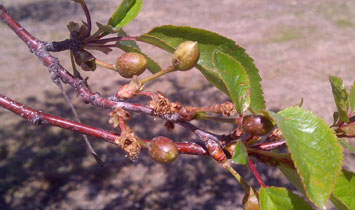How to minimize costs in frost-damaged cherry orchards
Growers that have frosted cherry orchards can use the following strategies to reduce input costs.
 The initial step in determining how to manage cherry orchards with frost damage is first assessing the amount of damage. Enough time has elapsed that cherries not damaged by frost or those that were successfully pollinated are starting to properly size. Cherries that are still in the shuck, brown in color, or very small in size are not likely to develop this season. The second decision is whether growers will harvest a particular block. If growers do intend to harvest, minimizing costs is probably not the best strategy.
The initial step in determining how to manage cherry orchards with frost damage is first assessing the amount of damage. Enough time has elapsed that cherries not damaged by frost or those that were successfully pollinated are starting to properly size. Cherries that are still in the shuck, brown in color, or very small in size are not likely to develop this season. The second decision is whether growers will harvest a particular block. If growers do intend to harvest, minimizing costs is probably not the best strategy.
If growers do, indeed, have too few cherries to shake a block, a few management strategies are still necessary for this season. First and foremost, cherry leaf spot control is vital. This pathogen infects the leaves, and even with no fruit, trees are still susceptible. Brown rot control, on the other hand, becomes a minimal concern as this pathogen infects the fruit. If no fruit is visible on the tree, brown rot control can be reduced. However, growers should keep in mind that even a small number of fruit on the tree can result in a brown rot infection, and these infected fruits can increase inoculum in subsequent years. The most important spray timing for powdery mildew control is the first cover timing (the first spray application after shuck split). In a year with no crop, this timing is even more important as a cost saving measure – essentially, if a grower applies a fungicide targeting powdery mildew at first cover timing, they will minimize the need to apply fungicides targeting powdery mildew later in the season.
Blocks where cherries will be harvested will need insecticide sprays to ensure marketable fruit. Trees with minimal fruit are more likely to be infested as there are simply fewer fruit in which plum curculio or cherry fruit fly females can lay eggs. If growers do not intend to harvest a particular block, insecticide sprays for plum curculio and cherry fruit flies can be eliminated. Growers should keep in mind that reducing or eliminating insecticide sprays for these pests could result in higher insect populations the following season. Green fruitworm sprays can also be eliminated with no fruit.
Two spotted spider mites can build up in an orchard with or without fruit; however, trees without fruit will be able to withstand more mite feeding than trees with fruit. Growers should monitor orchards later in the season for two spotted spider mites, particularly if temperatures are hot and dry and when the weeds under the canopy dry up and mites move into the trees.
Borers – lesser peachtree, peachtree and American plum borer – are all still potential problems for cherry orchards with minimal fruit. Borers do not feed or depend on the cherry fruit for their life cycle, and trees without fruit will still be susceptible to borer infestations. Trunk sprays are still recommended in orchards with little or no fruit.
Obliquebanded leafrollers are also still a concern for growers this season as these insects feed on cherry foliage rather than the fruit. These insects overwinter as larvae, and as leaves develop, they move to the terminals to feed. In a block with no fruit, a strategy to save money this season would be to spray either the spring overwintering larvae or the summer generation larvae rather than spraying at both times. However, we have found very few larvae in the orchards at this time, likely due to the cool weather. We typically target sprays at the overwintering larvae around petal fall, but this year we have not observed many larvae in the trees. If growers intend to spray at this timing, which is relatively soon (or now), we recommend that they wait until temperatures warm up and the larvae become more active. The other timing for control is approaching harvest where growers would target the summer generation larvae. These sprays can be difficult in a typical year as these insects web themselves inside the cherry clusters, therefore avoiding contact with the insecticide. But, in a year with no fruit, this generation may be more easily killed because the larvae will not be able to hide amongst the clusters.
For other management strategies, we offer the following recommendations.
- Gibberllic acid is necessary this season to ensure that the trees will not overset next year.
- Weed control can be minimized, but not eliminated, as trees without fruit will require less water.
- Micronutirents can be reduced unless growers observe a deficiency.
- Nitrogen applications could also be reduced, but more than likely spring applications have already been made this season.



 Print
Print Email
Email




